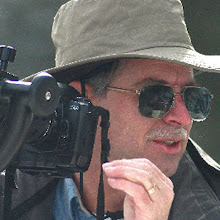Lunar eclipses occur several times per year, but total eclipses are a little more rare. We have a chance in the Western US (plus Alaska, Hawaii, and much of Asia) to see it in totality right near sunrise tomorrow. The image above was taken a year ago near Colorado Springs and is composed of a series of individual shots composited together using Photoshop. A 300mm lens with 1.4X teleconverter was used.
There are a number of good resources to predict the timing of eclipses which will help you plan your photographic strategy.
For example, it's generally a good idea to plan on some sort of foreground to make your shots more interesting to the viewer. This can be rock formations or mountain peaks. In the case of the Colorado Springs area, we have the Garden of the Gods rock formations and Pikes Peak - both worthy foreground subjects. Below, you'll see an example taken last year during the totality. The rock was light-painted by a strong flashlight during the 30-second exposure. This was
published in Sky & Telescope Magazine several months ago.
Here's a useful
link to more info on the eclipse tomorrow (from the EarthSky blog). To calculate the eclipse timing, we take you to the
U.S. Naval Observatory. This will customize the timing for your particular location. For Colorado Springs, we have the following data:
Total Eclipse of the Moon
COLORADO SPRINGS, COLORADO
o ' o '
W104 48, N38 51
Mountain Standard Time
Moon's
Azimuth Altitude
h m o o
Moonrise 2011 Dec 09 16:03 60.9 ----
Moon enters penumbra 2011 Dec 10 04:31.8 277.5 27.1
Moon enters umbra 2011 Dec 10 05:45.4 287.5 13.6
Moon enters totality 2011 Dec 10 07:05.7 299.0 0.2
Moonset 2011 Dec 10 07:09 299.4 ----
It turns out that totality begins about 7:05 AM Mountain Standard Time, which is very close to sunrise. Here's a handy
sunrise/sunset calculator that will help you plan whether to shoot at night or at sunrise (moon over the mountains at sunrise, for example). Be sure to check off "Moonrise/Moonset" and "Civil Twilight", which is the time the sun is 6 degrees below the horizon and when landforms (under clear skies) are clearly distinguished. This would be the time when you usually can start photographing your "sunrise" images.
Making a calendar for Colorado Springs, we get the following data:
Twi: 6:36am
Sunrise: 7:06am
Sunset: 4:37pm
Twi: 5:07pm
Moonrise: 4:54pm
Moonset: 7:09am
So, the important info would be the entry into the umbra (main Earth's shadow), which starts at 5:45 AM, the start of totality (7:05 AM), Civil Twilight (6:36 AM) and sunrise (7:06 AM).
If you wanted to photograph some recognizable landforms for viewer interest and a sense of scale, you'll want to be in position and photographing by civil twilight (6:36 AM) and the light from sunrise and any leftover light from the lunar eclipse should be relatively balanced. Note that at totality, the moon will be just above the horizon (for us here in Colorado), so if there are high mountain ranges, or other obstructions, we'll miss totality. There will still be opportunities for a partial eclipse, however.
If you wish to use the Garden of the Gods rock formations or Pikes Peak for your foreground, you'll note that as the moon enters the umbra, it is still 13.6 degrees in elevation, which may (not having measured this just yet) put it just above the mountain range here. Good locations might include the Garden of the Gods Visitor Center parking lot or the overlook off Mesa Road. I believe locating yourself at the main parking lot next to the formations will be too close to include the moon.
Another good bet would be to drive west on Highway 24 to Wilkerson Pass and (using large telephoto lens) photograph the moon before it sets over the Collegiate Range.
Looking forward to seeing your pictures!






















































